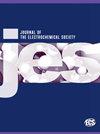使用含氯化钠的安全乙二醇溶液对镁及其合金进行电解抛光
IF 3.3
4区 工程技术
Q2 ELECTROCHEMISTRY
引用次数: 0
摘要
通过电化学测量、显微镜观察和反射率测量,研究了纯镁及其合金在含氯化钠的乙二醇(EG)、二甘醇(DEG)、三甘醇(TrEG)和四甘醇(TeEG)溶液中的电解抛光行为。在 EG 溶液中通过恒压电解,镁表面形成了大面积浅灰色浑浊区,并伴有微米级的线性不规则,而在 DEG 和 TeEG 溶液中则成功获得了镜面镁表面。其中,DEG 溶液因其较低的粘度和市场价格而被认为适合电解抛光。在 308 K 的 DEG 溶液中进行电解时,整个可见光波长区域的反射率随着时间的推移逐渐增加。我们发现,如果要快速获得中等抛光的表面,应选择在 75 V 的较高电压下进行 3 分钟的短期电解,而如果要获得反射率超过 80% 的高抛光表面,则应在 50 V 的电压下进行 60-300 分钟的长期电解。具有弯曲和螺旋形状的三维镁试样以及由简单固溶体基质组成的 LZ91 镁合金也可以通过在 DEG 溶液中电解进行电抛光。本文章由计算机程序翻译,如有差异,请以英文原文为准。
Electropolishing of Magnesium and Its Alloys Using a Safe Glycol Solution Containing Sodium Chloride
The electropolishing behavior of pure magnesium and its alloys in ethylene glycol (EG), diethylene glycol (DEG), triethylene glycol (TrEG), and tetraethylene glycol (TeEG) solutions containing sodium chloride was investigated using electrochemical measurements, microscopic observations, and reflectance measurements. Large light-grayish cloudy areas with micrometer-scale linear irregularities were formed on the magnesium surface via constant-voltage electrolysis in the EG solution, whereas mirror-finished magnesium surfaces were successfully obtained in the DEG and TeEG solutions. Among these, the DEG solution is considered appropriate for electropolishing because of its lower viscosity and market price. The reflectance of the entire visible wavelength region gradually increased with time during electrolysis in the DEG solution at 308 K. We found that short-term electrolysis for 3 min at the higher voltage of 75 V should be selected if a moderately polished surface is to be rapidly obtained, whereas long-term electrolysis for 60–300 min at 50 V should be performed if a highly polished surface with an extremely high reflectivity measuring more than 80% can be obtained. Three-dimensional magnesium specimens with curved and spiral shapes and an LZ91 magnesium alloy consisting of a simple solid-solution matrix can also be electropolished via electrolysis in a DEG solution.
求助全文
通过发布文献求助,成功后即可免费获取论文全文。
去求助
来源期刊
CiteScore
7.20
自引率
12.80%
发文量
1369
审稿时长
1.5 months
期刊介绍:
The Journal of The Electrochemical Society (JES) is the leader in the field of solid-state and electrochemical science and technology. This peer-reviewed journal publishes an average of 450 pages of 70 articles each month. Articles are posted online, with a monthly paper edition following electronic publication. The ECS membership benefits package includes access to the electronic edition of this journal.

 求助内容:
求助内容: 应助结果提醒方式:
应助结果提醒方式:


